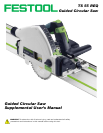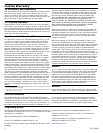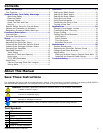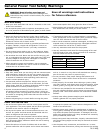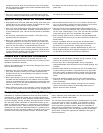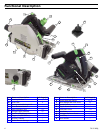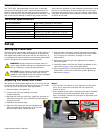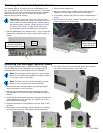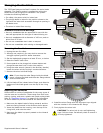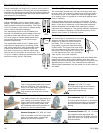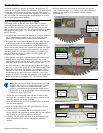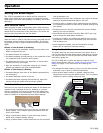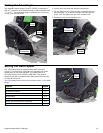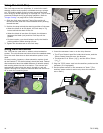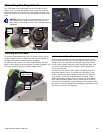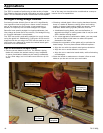
Supplemental Owner’s Manual 5
conditions and the work to be performed. Use of the power
tool for operations different from those intended could result
in a hazardous situation.
► To reduce the risk of serious injury, never alter or misuse the
power tool.
Service
► Have your power tool serviced by a qualied repair person
using only identical replacement parts. This will ensure that
the safety of the power tool is maintained.
Specic Safety Rules for Circular Saws
► Keep hands away from the blade and cutting area. Keep your
second hand on the auxiliary handle. If both hands are hold-
ing the saw, they cannot be cut by the blade.
► Keep your body positioned to either side of the saw blade, but
not in line with the saw blade. Kickback could cause the saw
to jump backward. (See “Causes and Prevention of Kickback”
below.)
► Do not reach underneath the workpiece. The blade is fully
exposed under the workpiece.
► Never use a plunging circular saw that fails to return to its
unplunged position. If the saw ever fails to fully retract the
sawblade as expected, immediately stop using the saw and
have the saw serviced by an authorized service center.
► Never use a dust extraction system when making cuts that
can result in sparks, such as cutting through nails and other
ferrous materials. Sparks and hot embers can cause a re or
explosion in the dust extraction system.
► Never hold the piece being cut in your hands or across your
leg. It is important to support the work properly to minimize
body exposure, blade binding, or loss of control.
► Hold the saw by the insulated handles when performing an
operation in which the sawblade may contact hidden wiring or
its own cord. Contact with a “live” wire will make the exposed
metal parts of the tool “live” and shock the operator.
► When ripping, always use a rip fence or straight edge guide.
This improves the accuracy of cut and reduces the chance for
blade binding.
► Always use blades with the correct size and shape arbor
holes. Blades that do not match the mounting hardware of
the saw will run eccentrically, causing loss of control.
► Never use damaged or incorrect blade anges or bolt. The
blade anges and bolt were specially designed for your saw
for optimum performance and safety of operation.
Causes and Prevention of Kickback
Kickback is a sudden reaction to a pinched, bound, or mis-
aligned saw blade that causes the saw to lift up and out of the
workpiece toward the operator.
Chances for kickback may be reduced by taking proper precau-
tions as described below:
► Maintain a rm grip with both hands on the saw and position
your body and arm to allow you to resist kickback forces.
Kickback forces can be controlled by the operator if proper
precautions are taken.
► When interrupting a cut for any reason, release the trigger
and hold the saw motionless in the material until the blade
comes to a complete stop. Never attempt to remove the saw
from the work or pull the saw backward while the blade is in
motion, or kickback may occur.
► When restarting a saw in the workpiece, center the saw blade
in the kerf and check that the saw teeth are not engaging the
material. If the saw blade is binding during a restart, it may
climb up or kickback from the workpiece.
► Do not use a dull or damaged blade. Dull or improperly
sharpened blades cause excessive friction, blade binding, and
kickback.
► Support large panels to minimize the risk of the blade pinch-
ing and causing a kickback. Large panels tend to sag under
their own weight. Supports must be placed under the panel
on both sides, near the line of cut and near the edge of the
panel.
► The bevel adjusting knobs must be fully tightened before
making a cut. If the blade tilts during a cut, it will bind and
cause a kickback.
► Use extra caution when making a plunge cut into existing
walls or other blind areas. The protruding blade may cut
objects that can cause kickback.
Respiratory Exposure Safety Warnings
Substantial or repeated inhalation of dust and other airborne
contaminants, in particular those with a smaller particle size,
may cause respiratory or other illnesses. Various dusts created
by power sanding, sawing, grinding, drilling and other construc-
tion activities contain chemicals or substances known (to the
State of California and others) to cause cancer, birth defects or
other reproductive harm. Some examples of these chemicals/
substances are: lead from lead-based paints; crystalline silica
from bricks, cement, and other masonry products; arsenic and
chromium from chemically-treated lumber; and some wood
dusts, especially from hardwoods, but also from some soft-
woods such as Western Red Cedar.
The risk from these exposures varies, depending on how often
you do this type of work. To reduce your exposure to these
chemicals: work in a well ventilated area and use a properly
functioning dust extraction system. When the inhalation of
dust cannot be substantially controlled, i.e., kept at or near the
ambient (background) level, the operator and any bystanders
should wear a respirator approved by NIOSH for the type of
dust encountered.



